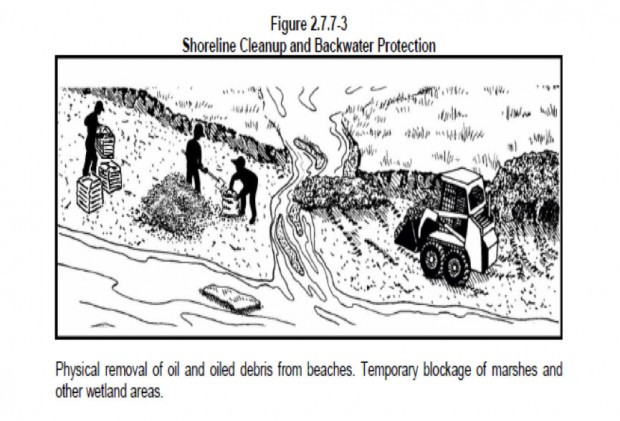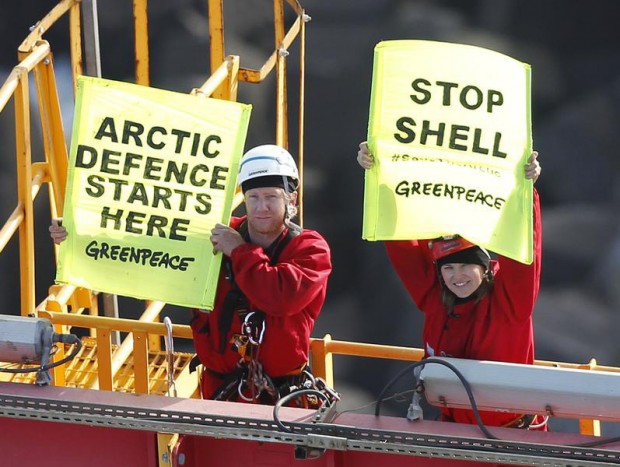Today, we’re in for a treat – another glimpse into the fantastical world of the Arctic oil spill response plan writer.
Shell and Cairn Energy – who have both tried to use brute legal force to obstruct public scrutiny of their Arctic drilling plans and to silence Greenpeace and our supporters (more on that below) – are going to be subjected to a bit of parliamentary scrutiny. This afternoon, both companies will be giving evidence to a UK parliamentary inquiry on protecting the Arctic.
You can watch the session live at 3pm (and we’ll be tweeting any highlights). Until then, here are a few of the questions we’re hoping MPs will ask Shell and Cairn:
Do you agree that it would be impossible for a blowout to occur off Alaska at the end of the drilling season?
Shell has come up with a number of worst case scenarios in its spill response plan. But we’ve noticed that in these scenarios, the Arctic oil spill only ever happens in the summer. The drilling season stretches well into the autumn so we’d like to know: what would happen if a blowout happened on the 31 October? How would Shell stop the blowout before the Arctic winter sets in? If the blowout was somehow stopped, how would Shell find oil trapped beneath thousands of individual bits of floating ice which would then float hundreds of miles in different directions across the Arctic Ocean?

Tara the dachsund
How does Shell plan to track leaking oil deep under the Arctic pack ice?
We already know Shell’s answer to this question but we’d like to hear them stand up and say it to a committee of MPs with a straight face. The answer is sniffer dogs. Specifically, Tara the dachshund and border collies Jippi and Blues. I kid you not.
Do Cairn / Shell accept their worst case scenario modelling does not adequately reflect a worst case?
Apart from the dodgy assumptions around when a spill might happen, there’s also the question of how much oil would be pumped into Arctic waters if a spill did happen. In its worst case scenario, Cairn plumped for a modest 5,000 barrels a day over 37 days. Shell went for a round 25,000 barrels a day over 30 days. But the US Bureau of Ocean Energy Management (BOEM) and Professor Richard Steiner both put the worst case discharge rate at around 60,000 barrels a day – over 74 to 85 days.
How much experience do you have of same-season drilling of relief wells with a single rig in the Arctic?
Cairn reckons it could drill a relief well in the Arctic in 34 days (although, to be fair, Cairn admits it just copied and pasted this figure from someone else’s Arctic plan). Shell reckons it would take them 38 days. BP – working in the relatively balmy Gulf of Mexico - took 85 days to drill a relief well, due to bad weather. Imperial Oil reckons a relief well could not be finished in the same drilling season; a main well could take two or three summers to complete.
Why is capping a well now technically feasible when Shell judged it not to be in 2009 and 2010?
Shell’s 2009 and 2010 oil spill response plans ruled out capping a well as ‘technically infeasible’. Now Shell is relying on capping a well in the event of a spill. The capping and containment system it plans to use hasn’t been built yet, and no final construction date is mentioned in its plans. Cairn mentions well capping but doesn’t bother to specify what capping equipment it will use, or how.
Why won’t Shell test its dome in icy conditions when it admits these conditions could be present in the up-coming Alaskan drilling window?
Shell has no plans to test the containment system in icy conditions. This is probably because, even if it existed, it wouldn’t work; all of BP’s attempts to use various capping domes in the Gulf of Mexico totally failed.
How does Shell plan to clean up an oil spill when ice is present?
As the flow of oil into ice can’t be easily stemmed, you’d hope that Shell would have some solid plans in place to clean it up (assuming Tara manages to find it). Unfortunately, there is no known way of dealing with an oil spill when ice is present: mechanical recovery becomes useless (according to the oil industry), in-situ burning becomes impossible after the oil has been weathered for six days (according to Shell-funded research by JIP) and chemical dispersants are ineffectual (see the Gulf of Mexico) and poorly understood in terms of their long term impact on the environment.
But at least it has plans for onshore cleanup (again, I kid you not - this is taken straight from the Shell spill response plan on which the fate of Arctic biodiversity may rest):

If BP needed 6,500 ships and 50,000 people to mount a response to Deepwater Horizon, what is your secret that gives you such confidence you could do the job with so comparatively few resources?
The resources Shell has allocated to deal with a spill are pitifully small. And of course, in the Arctic, almost no infrastructure exists. Pew again: “there are insufficient airports, ports and roads along the Chukchi Sea coastline to support a spill response effort…there are no roads connecting the Chukchi Sea coast to the rest of Alaska.”
What is it about your oil spill response plan that makes you so keen to have it ring-fenced from possible legal challenges?
Last year, Cairn Energy won a wide-ranging and draconian injunction against Greenpeace UK and Greenpeace International after polar bears entered their headquarters to search for the oil spill response plan.
Just recently, Shell filed for an extraordinarily wide ranging injunction against Greenpeace USA to prevent it - and its 500,000 supporters - from taking action at any petrol station, regional office or other Shell venue. It was rejected by the courts but the full hearing takes place on the 19 March. Shell has also filed a second, unprecedented, lawsuit against a broad range of NGOs which seeks to prevent any possible future legal challenge of their Chukchi oil spill response plan in the US courts.
Once the inquiry has published its recommendations, there will be an opportunity for us all to ask the government to implement them - we’ll send you an email when that time comes. In the mean time, if you fancy a career as an oil spill response plan writer, feel free to get creative with suggestions on how to clean up Arctic oil spills in the comments. And, if you haven’t already, please, please add your voice to the chorus of 250,000-odd calling on Shell to stay out of the Arctic.



